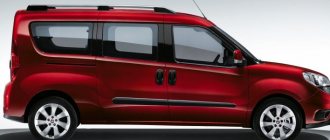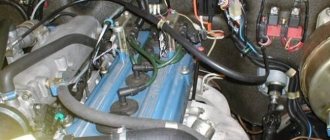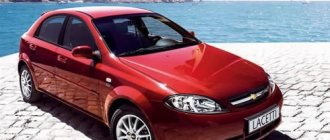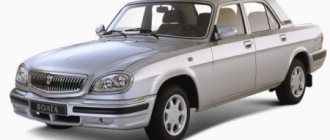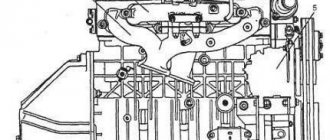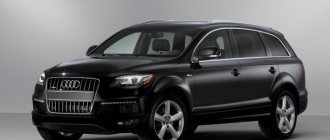Mitsubishi launched Pajero production in 1982 and has already produced 8 generations and 146 modifications, with engine packages that support the environmental standards EURO IV, EURO III, EURO II, EURO V with volumes: 2346, 2476, 2477, 2835, 2972, 3200, 3497, 3828 cm3 and power: 84, 99, 105, 115, 125, 141, 150, 160, 163, 165, 170, 173, 174, 177, 178, 190, 194, 200, 202, 203, 220, 245, 250 l./s., using as fuel: diesel, gasoline, brands DT, AI-92, AI-95, with gearbox: automatic, manual. Read the full description: Mitsubishi Pajero on Wikipedia (official page). And the fuel consumption of the Mitsubishi Pajero in the mixed, urban (in the city) and suburban (on the highway) cycle ranges from 7.4 to 19.5 liters per 100 km, which is with a tank volume of 60, 69, 71, 75, 88, 90 , 92 liters, allows you to travel a distance of 380 km. up to 1190 km.. In addition, in various modifications additional options were used that expand and improve the capabilities of the fuel system (generations are indicated in parentheses, including restyling to which this option applies):
- Remote opening of the gas tank flap from the passenger compartment (1)
- Drive handle for fuel filler flap and trunk lid (2)
- Remote control of fuel filler flap (3)
Fuel consumption per 100 km for Mitsubishi Pajero (2006 - 2011), SUV, 4th generation
| Modification | Fuel consumption, l/100 km | Power reserve (km.) | ||
| highway | city | MIX | ||
| 3200 cm³, 170 hp, tank (69 l.) - diesel engine, manual transmission, all-wheel drive | 7.6 | 11.9 | 9.2 | 580 — 910 |
| 3200 cm³, 190 hp, tank (88 l.) - diesel engine, automatic transmission, all-wheel drive | 8 | 11.4 | 9.3 | 770 — 1100 |
| 3200 cm³, 190 hp, tank (69 l.) - diesel engine, manual transmission, all-wheel drive | 7.4 | 11 | 8.7 | 630 — 930 |
| 3200 cm³, 170 hp, tank (88 l.) - diesel engine, automatic transmission, all-wheel drive | 8 | 11.4 | 9.3 | 770 — 1100 |
| 3200 cm³, 170 hp, tank (88 l.) - diesel engine, manual transmission, all-wheel drive | 7.4 | 11 | 8.7 | 800 — 1190 |
| 3200 cm³, 170 hp, tank (69 l.) - diesel engine, automatic transmission, all-wheel drive | 9 | 13.1 | 10.5 | 530 — 770 |
| 3200 cm³, 190 hp, tank (69 l.) - diesel engine, automatic transmission, all-wheel drive | 8 | 11.4 | 9.3 | 610 — 860 |
| 2972 cm³, 178 hp, tank (88 l.) - AI-92, automatic transmission, all-wheel drive | 10 | 15.9 | 12.2 | 550 — 880 |
| 2972 cm³, 178 hp, tank (88 l.) - AI-92, manual transmission, all-wheel drive | 10 | 15.8 | 12.2 | 560 — 880 |
| 3200 cm³, 200 hp, tank (88 l.) - diesel engine, automatic transmission, all-wheel drive | 8 | 11.4 | 9.3 | 770 — 1100 |
| 3200 cm³, 165 hp, tank (88 l.) - diesel engine, automatic transmission, all-wheel drive | — | — | 10.6 | up to 830 |
| 3200 cm³, 160 hp, tank (88 l.) - diesel engine, automatic transmission, all-wheel drive | 9.1 | 13.1 | 10.6 | 670 — 970 |
| 3200 cm³, 165 hp, tank (88 l.) - diesel engine, manual transmission, all-wheel drive | 8 | 11.5 | 9.3 | 770 — 1100 |
| 3200 cm³, 160 hp, tank (88 l.) - diesel engine, manual transmission, all-wheel drive | 8 | 11.5 | 9.3 | 770 — 1100 |
| 3828 cm³, 250 hp, tank (88 l.) - AI-95, automatic transmission, all-wheel drive | 11.2 | 17.7 | 13.5 | 500 — 790 |
| 3200 cm³, 165 hp, tank (69 l.) - diesel engine, automatic transmission, all-wheel drive | 9.1 | 13.1 | 10.6 | 530 — 760 |
| 3200 cm³, 160 hp, tank (69 l.) - diesel engine, manual transmission, all-wheel drive | 7.9 | 11.4 | 9.2 | 610 — 870 |
| 3200 cm³, 165 hp, tank (69 l.) - diesel engine, manual transmission, all-wheel drive | 9 | 13.1 | 10.5 | 530 — 770 |
| 3200 cm³, 200 hp, tank (69 l.) - diesel engine, manual transmission, all-wheel drive | 9 | 13.1 | 10.5 | 530 — 770 |
| 3828 cm³, 250 hp, tank (69 l.) - AI-95, automatic transmission, all-wheel drive | 11.2 | 17.6 | 13.4 | 390 — 620 |
Dynamics of Pajero
The slowest when accelerating to 100 km/h is the diesel until 2009 (at 165 hp). Almost identically, they come with three-liter gasoline (up to 40 km/h, diesel even accelerates a little faster, but closer to 50-60 km/h it begins to lag). The more recent 190 and 200 hp diesel engines demonstrate much better dynamics. The fastest production Pajero with a 3.8 Mivec engine with 250 hp. The picture of the “weak” dynamics of diesel engines can be significantly improved if you install. Then even the weakest 165 horsepower begins to approach the performance of 3.8, and the 200 horsepower already turns out to be the fastest in acceleration.
Its high price, however, positions it as a delicacy for those who want to have the best examples of their kind in their garage. And unless you live at the top of Aconcagua, you're better off saving your space for more casual and urban transportation. Type: longitudinal front, diesel, 4 cylinders in line, 16 valves, direct injection direct injection, variable turbine turbo with intercooler.
Rear differential with manual locking. Rear suspension: independent, with deformable parallelogram, coil spring and stabilizer. Front brakes: Ventilated discs. Rear brakes: Ventilated discs. Direction: Gear and rack, with hydraulic servo drive.
Fuel consumption per 100 km for Mitsubishi Pajero (2000 - 2006), SUV, 3rd generation
| Modification | Fuel consumption, l/100 km | Power reserve (km.) | ||
| highway | city | MIX | ||
| 2477 cm³, 105 hp, tank (71 l.) - diesel engine, manual transmission, all-wheel drive | 9.1 | 13.3 | 10.6 | 530 — 780 |
| 2972 cm³, 173 hp, tank (71 l.) - AI-92, automatic transmission, all-wheel drive | 11.1 | 17.7 | 13.6 | 400 — 640 |
| 2972 cm³, 173 hp, tank (71 l.) - AI-92, manual transmission, all-wheel drive | 10.9 | 17.6 | 13.5 | 400 — 650 |
| 3200 cm³, 165 hp, tank (71 l.) - diesel engine, automatic transmission, all-wheel drive | 8.7 | 13.3 | 10.5 | 530 — 820 |
| 3200 cm³, 165 hp, tank (71 l.) - diesel engine, manual transmission, all-wheel drive | 7.9 | 12.4 | 9.5 | 570 — 900 |
| 3497 cm³, 220 hp, tank (71 l.) - AI-95, automatic transmission, all-wheel drive | 10.8 | 17.5 | 14.2 | 410 — 660 |
| 3497 cm³, 194 hp, tank (71 l.) - AI-92, manual transmission, all-wheel drive | 10.6 | 17.8 | 13.3 | 400 — 670 |
| 2477 cm³, 115 hp, tank (90 l.) - diesel engine, manual transmission, all-wheel drive | 9.2 | 13.4 | — | 670 — 980 |
| 2972 cm³, 173 hp, tank (90 l.) - AI-92, automatic transmission, all-wheel drive | 11.1 | 17.7 | 13.6 | 510 — 810 |
| 2972 cm³, 173 hp, tank (90 l.) - AI-95, manual transmission, all-wheel drive | 10.9 | 17.6 | 13.5 | 510 — 830 |
| 3200 cm³, 165 hp, tank (90 l.) - diesel engine, automatic transmission, all-wheel drive | 8.8 | 13.3 | 10.5 | 680 — 1020 |
| 3200 cm³, 165 hp, tank (90 l.) - diesel engine, manual transmission, all-wheel drive | 7.9 | 12.1 | 9.5 | 740 — 1140 |
| 2835 cm³, 125 hp, tank (71 l.) - diesel engine, automatic transmission, all-wheel drive | 11.3 | 15.3 | 12.8 | 460 — 630 |
| 2835 cm³, 125 hp, tank (71 l.) - diesel engine, manual transmission, all-wheel drive | 9.6 | 13.9 | 11.2 | 510 — 740 |
| 3497 cm³, 194 hp, tank (71 l.) - AI-92, automatic transmission, all-wheel drive | 11 | 18.1 | 13.7 | 390 — 650 |
| 3497 cm³, 202 hp, tank (71 l.) - AI-95, automatic transmission, all-wheel drive | 10.8 | 17.5 | 14.2 | 410 — 660 |
| 3497 cm³, 220 hp, tank (71 l.) - AI-95, manual transmission, all-wheel drive | 10.5 | 16.9 | 12.9 | 420 — 680 |
| 3497 cm³, 202 hp, tank (71 l.) - AI-95, manual transmission, all-wheel drive | 10.9 | 18.8 | — | 380 — 650 |
| 2835 cm³, 125 hp, tank (90 l.) - diesel engine, automatic transmission, all-wheel drive | 11.3 | 15.3 | 12.8 | 590 — 800 |
| 2835 cm³, 125 hp, tank (90 l.) - diesel engine, manual transmission, all-wheel drive | 10.6 | 15.4 | 12.4 | 580 — 850 |
| 3497 cm³, 202 hp, tank (90 l.) - AI-95, automatic transmission, all-wheel drive | 11.1 | 19.5 | 14.2 | 460 — 810 |
| 3497 cm³, 194 hp, tank (90 l.) - AI-92, automatic transmission, all-wheel drive | 11.3 | 18.6 | 14 | 480 — 800 |
| 3497 cm³, 202 hp, tank (90 l.) - AI-95, manual transmission, all-wheel drive | 10.7 | 17.1 | 13.1 | 530 — 840 |
| 3497 cm³, 194 hp, tank (90 l.) - AI-95, manual transmission, all-wheel drive | 10.8 | 18.1 | 13.5 | 500 — 830 |
Fuel consumption per 100 km for Mitsubishi Pajero (1994 - 2000), SUV, 3rd generation [restyling]
| Modification | Fuel consumption, l/100 km | Power reserve (km.) | ||
| highway | city | MIX | ||
| 3497 cm³, 194 hp, tank (90 l.) - AI-92, automatic transmission, all-wheel drive | 11.3 | 18.6 | 14 | 480 — 800 |
| 3497 cm³, 203 hp, tank (90 l.) - AI-95, automatic transmission, all-wheel drive | 11.1 | 19.5 | 14.2 | 460 — 810 |
| 3497 cm³, 194 hp, tank (90 l.) - AI-92, manual transmission, all-wheel drive | 10.8 | 18.1 | 13.5 | 500 — 830 |
| 3497 cm³, 203 hp, tank (90 l.) - AI-95, manual transmission, all-wheel drive | 10.7 | 17.1 | 13.1 | 530 — 840 |
| 3497 cm³, 203 hp, tank (71 l.) - AI-95, automatic transmission, all-wheel drive | 10.8 | 17.5 | 14.2 | 410 — 660 |
| 3497 cm³, 202 hp, tank (71 l.) - AI-95, manual transmission, all-wheel drive | 10.9 | 18.8 | — | 380 — 650 |
| 3200 cm³, 163 hp, tank (90 l.) - diesel engine, automatic transmission, all-wheel drive | 8.8 | 13.3 | 10.5 | 680 — 1020 |
| 3200 cm³, 163 hp, tank (90 l.) - diesel engine, manual transmission, all-wheel drive | 7.9 | 12.1 | 9.5 | 740 — 1140 |
| 3200 cm³, 163 hp, tank (71 l.) - diesel engine, automatic transmission, all-wheel drive | 8.7 | 13.3 | 10.5 | 530 — 820 |
| 3200 cm³, 163 hp, tank (71 l.) - diesel engine, manual transmission, all-wheel drive | 7.9 | 12.4 | 9.5 | 570 — 900 |
Fuel consumption per 100 km for Mitsubishi Pajero (1982 - 1991), SUV, 2nd generation [restyling]
| Modification | Fuel consumption, l/100 km | Power reserve (km.) | ||
| highway | city | MIX | ||
| 2477 cm³, 99 hp, tank (92 l.) - diesel engine, automatic transmission, all-wheel drive | 8.3 | 12.3 | 10.7 | 750 — 1110 |
| 2477 cm³, 99 hp, tank (92 l.) - diesel engine, manual transmission, all-wheel drive | 9.3 | 13.8 | 11.2 | 670 — 990 |
| 2972 cm³, 177 hp, tank (92 l.) - AI-95, automatic transmission, all-wheel drive | 10.7 | 16.2 | 14.9 | 570 — 860 |
| 2972 cm³, 177 hp, tank (92 l.) - AI-95, manual transmission, all-wheel drive | 10.6 | 16.6 | 14.7 | 550 — 870 |
| 2477 cm³, 99 hp, tank (75 l.) - diesel engine, manual transmission, all-wheel drive | 9.3 | 13.2 | 10.7 | 570 — 810 |
| 2835 cm³, 125 hp, tank (92 l.) - diesel engine, automatic transmission, all-wheel drive | 10.7 | 15.5 | 12.5 | 590 — 860 |
| 2835 cm³, 125 hp, tank (92 l.) - diesel engine, manual transmission, all-wheel drive | 10.7 | 15.5 | 12.5 | 590 — 860 |
| 3497 cm³, 194 hp, tank (92 l.) - AI-95, automatic transmission, all-wheel drive | 11.1 | 18.2 | 13.7 | 510 — 830 |
| 3497 cm³, 245 hp, tank (92 l.) - AI-92, automatic transmission, all-wheel drive | 11.1 | 18.2 | 13.7 | 510 — 830 |
| 3497 cm³, 245 hp, tank (92 l.) - AI-95, manual transmission, all-wheel drive | 11.6 | 19 | 14.5 | 480 — 790 |
| 3497 cm³, 194 hp, tank (92 l.) - AI-95, manual transmission, all-wheel drive | 11.1 | 18.2 | 14.5 | 510 — 830 |
| 2477 cm³, 99 hp, tank (75 l.) - diesel engine, automatic transmission, all-wheel drive | 8.8 | 13.3 | 10.4 | 560 — 850 |
| 2835 cm³, 125 hp, tank (75 l.) - diesel engine, automatic transmission, all-wheel drive | 9.6 | 14.1 | 11.3 | 530 — 780 |
| 2835 cm³, 125 hp, tank (75 l.) - diesel engine, manual transmission, all-wheel drive | 9.6 | 14.1 | 11.3 | 530 — 780 |
| 2972 cm³, 177 hp, tank (75 l.) - AI-95, automatic transmission, all-wheel drive | 10.9 | 17.6 | 13.5 | 430 — 690 |
| 2972 cm³, 177 hp, tank (75 l.) - AI-95, manual transmission, all-wheel drive | 10.9 | 17.6 | 13.5 | 430 — 690 |
| 3497 cm³, 245 hp, tank (75 l.) - AI-92, automatic transmission, all-wheel drive | 11.1 | 18.2 | 13.7 | 410 — 680 |
| 3497 cm³, 194 hp, tank (75 l.) - AI-95, automatic transmission, all-wheel drive | 11.1 | 18.2 | 13.7 | 410 — 680 |
| 3497 cm³, 245 hp, tank (75 l.) - AI-95, manual transmission, all-wheel drive | 11.1 | 18.2 | 13.7 | 410 — 680 |
| 3497 cm³, 194 hp, tank (75 l.) - AI-95, manual transmission, all-wheel drive | 11.1 | 18.2 | 13.7 | 410 — 680 |
Engine type, volume
Fuel consumption rate of Mitsubishi Pajero Sport 1st generation 2nd. I bought my Pajero Sport from a good friend last year. He is the only owner, purchased it in the city.
Version with turbodiesel 2. The car is not bad - it breaks down, no matter what, but repairs are relatively inexpensive. Diesel fuel consumption is 12 liters maximum, usually within the limits.
Mitsubishi Pajero Sport, 2. A tank, not a car. Of course, you need to drive without fanaticism - since I decided to prove on a bet that I could drive through an almost impassable swamp, I naturally sat right up to the headlights, and was barely pulled out with a tractor.
And the cross-country ability is excellent. And the diesel consumption is small - 15 liters maximum in winter, 9 liters on the highway. I work as a driver for a company that repairs drilling equipment, and I often have to drive my boss to sites.
The car was bought new from the showroom.
The main reasons for increased fuel consumption
Consumption is on average liters, if you go to the tundra it’s 14 liters. I have respected Mitsubishi for a long time - the company has several Pajero and L, and this is the only way they drive around the taiga. The Pajero Sport is not particularly inferior to them in terms of cross-country ability - once it flew into a ditch, it got out without any problems at all.
And what suits me most is the consumption of diesel fuel - for such a jeep weighing 2 tons, it consumes only a liter, no more.
Mitsubishi Pajero Sport, all-wheel drive with a turbodiesel, a real frame jeep, no fools, no match for these polished and polished SUVs, which will not even drive in the snow.
At the same time, it is simple and reliable, like an UAZ. Diesel fuel consumption is ridiculous - highway 9 liters, city liters, no more. Driving experience: 46 years, driven in all domestic cars, starting with Oka and ending with RAFik.
The last of the domestic automobile industry was VAZ, after which I decided that my next car would certainly be an SUV, and an imported one. From the available budget, I chose the Mitsubishi Pajero Sport of the year, and immediately took a diesel engine with a manual transmission.
In the city, of course, about 13 liters, but this is also normal. Mitsubishi Pajero Sport 2nd generation 3. Now the engine developed power in hp. A 4-speed and a 5-speed automatic are added to the traditional 5-speed manual transmission. Real reviews about the fuel consumption of Mitsubishi Pajero Sport 2nd generation 3. Immediately after buying my Mitsubishi Pajero Sport last year, I took it to a service center, where they do modifications and the guys made me a real tank.
Since I was taking gasoline, I didn’t turn down the noise - and that’s normal.
Pajero VS Prado - fuel consumption.
This is the second car - my wife uses the first Toyota Corolla, but I drive a company car, but we take the Padzherik if we go out into nature or in winter. The salon in it is simply huge, there is a ton of space. If the driving style is uneven and disturbed, then the volume of fuel increases significantly.
The average fuel consumption of the Mitsubishi Pajero Sport on the highway is about 7 liters.
Mitsubishi Pajero 2.5
If the driver often switches from one speed to another and constantly brakes, the volume can increase to 10 liters. Experienced drivers know that whichever driver gets behind the wheel, the trip will be as comfortable and economical as possible. Road surface When buying a car, it is very important for every driver to know what the fuel costs are and whether traveling with this car will be economical. Also, the future owner of an SUV plans where and on what roads he will drive.
Fuel consumption per 100 km for Mitsubishi Pajero (since 2014), SUV, 4th generation [2nd restyling]
| Modification | Fuel consumption, l/100 km | Power reserve (km.) | ||
| highway | city | MIX | ||
| 3200 cm³, 190 hp, tank (88 l.) - diesel engine, automatic transmission, all-wheel drive | 8 | 11.4 | 9.3 | 770 — 1100 |
| 3200 cm³, 200 hp, tank (88 l.) - diesel engine, automatic transmission, all-wheel drive | 8 | 11.4 | 8.9 | 770 — 1100 |
| 3828 cm³, 250 hp, tank (88 l.) - AI-95, automatic transmission, all-wheel drive | 11.2 | 17.7 | 13.5 | 500 — 790 |
| 2972 cm³, 178 hp, tank (88 l.) - AI-92, automatic transmission, all-wheel drive | 10 | 15.9 | 12.2 | 550 — 880 |
| 2972 cm³, 178 hp, tank (88 l.) - AI-92, manual transmission, all-wheel drive | 10 | 15.8 | 12.2 | 560 — 880 |
| 2972 cm³, 174 hp, tank (88 l.) - AI-92, automatic transmission, all-wheel drive | 10.2 | 17 | 12.7 | 520 — 860 |
Pajero service cost
- Maintenance (or routine maintenance - changing oil, filters, etc.). In the short term, gasoline engines are more profitable. The cost of standard maintenance for a petrol Pajero is about $80
(Changing engine oil, oil filter, chassis diagnostics, injecting the crosspiece, replacing the air filter).
The cost of standard maintenance for a diesel Pajero is about $165.
That is, more than 2200 UAH more expensive than a gasoline car (at an exchange rate of 26 UAH/dollar). And so on every 10 thousand km. Of course, the difference will be made up by half when the time comes for major maintenance on the Pajero’s gasoline engine.
The cost of a large maintenance (TO-80) for a petrol Pajero is about $550
(this includes replacing the timing belt on the Pajero and spark plugs and oil in the automatic transmission and axles). For comparison,
the cost of a large maintenance (TO-80) for a diesel Pajero is about $350.
Approximate cost of all maintenance per 100,000 km Pajero: - petrol: about 1600$ - diesel: about 2100$
The rim dimension appears smaller, but only because of the large wheel diameter, something logical in a vehicle focused on field use. The side is complemented by silver taillights and roof bars in body color. Side indicators are built into the mirrors. Generally, the exterior gives the feeling of a well-finished car and ready for any road to take us to the field we lose with Montero. And we will, but before we open the driver's door.
Inside the Montero we feel quite elevated, which enhances the car's on-campus feel and, like the outside, it's all great. The instrument panel is fairly simple and made of hard plastics, but it has everything we need and its shape gives a feeling of strength and power.
- Cost of unscheduled repairs of Pajero (pads, shock absorbers, balls, etc.).
On this point we can say that all Pajero are almost equal - the differences in the chassis are global only in the brake system (Pajero 3.2 and 3.8 have one brake system, 3.0 has another... noticeably weaker) In fact, the price - the cost of brake pads on Pajero 3.0 will be cheaper about $5 per set than for 3.2/3.8, and the brake discs will differ by $10-15 apiece. Therefore, per 100,000 km the difference in maintenance will be approximately $100. We consider the cost of unscheduled repairs to be conditionally equal. Let's calculate the average cost of Pajero repairs per 100,000 km. Typically, during this mileage you will need to replace brake discs (300 euros for 4 pieces), brake pads twice (200 euros for 2 sets of front and 2 sets of rear Brembo), 4 pieces of ball joints (200 euros according to the original), 2 steering rods (120 euros) orig), pressure bearing in the steering wheel (70ue), maybe 4 shock absorbers (120 and 140 front/rear). Of course, it’s not a fact that all this needs to be changed every 100 thousand km, many people drive 300 thousand km before the chassis is repaired, but the roads of Ukraine are full of surprises... In total, the cost of unscheduled repairs for 100,000 km of Pajero will be in the range of 1000-1300 euros, which Compared to fuel consumption, it’s quite good!
Let's summarize the Pajero's efficiency. The most economical will be the Pajero Wagon with 3.0 with LPG (about 10,000 cu per 100,000 km for fuel, maintenance and unscheduled repairs), the most uneconomical will be the Pajero 3.2 diesel until 2009 (about 12,900 cu per 100,000 km for fuel, maintenance and unscheduled repairs). Or 0.1 ye versus 0.13 ye per km.
All data is accompanied by a graph showing the measurement of selected data four hours before the present. Its operation is simple and the menus are quite clear, so we didn't find any problems while using it. Because this area of the dashboard houses the air conditioning controls.
The leather-wrapped four-spoke multifunction steering wheel has controls for the audio system, speed control and telephone controls. Behind the steering wheel, on the left side, are the buttons for adjusting the mirrors, those that light the fog and those that activate the automatic change between short and long lights.
Fuel consumption per 100 km for Mitsubishi Pajero (2011 - 2014), SUV, 4th generation [restyling]
| Modification | Fuel consumption, l/100 km | Power reserve (km.) | ||
| highway | city | MIX | ||
| 2972 cm³, 178 hp, tank (88 l.) - AI-92, manual transmission, all-wheel drive | 10 | 15.8 | 12.2 | 560 — 880 |
| 2972 cm³, 178 hp, tank (88 l.) - AI-92, automatic transmission, all-wheel drive | 10 | 15.9 | 12.2 | 550 — 880 |
| 3200 cm³, 190 hp, tank (88 l.) - diesel engine, automatic transmission, all-wheel drive | 8 | 11.4 | 9.3 | 770 — 1100 |
| 3200 cm³, 200 hp, tank (88 l.) - diesel engine, automatic transmission, all-wheel drive | 8 | 11.4 | 8.9 | 770 — 1100 |
| 3200 cm³, 200 hp, tank (88 l.) - diesel engine, manual transmission, all-wheel drive | — | — | 8.4 | up to 1048 |
| 3828 cm³, 250 hp, tank (88 l.) - AI-95, automatic transmission, all-wheel drive | 11.2 | 17.7 | 13.5 | 500 — 790 |
Automatic transmission Pajero
The 3.0 petrol engine is equipped with a 4-speed automatic transmission, the rest of the Pajero engines are equipped with a 5-speed automatic transmission. Gearboxes, both 4-speed and 5-speed, are quite durable and are capable of maintaining more than 500,000 km without repairs with proper operation and timely oil changes (every 40 thousand km, preferably with a filter and the oil must comply with Mitsubishi tolerances) All Pajero automatic transmissions are adaptive, that is adapt to driving style.
We scratched it several times during testing. With its weight of 2.3 tons and contrary to what you might think, it does not have great fuel consumption. Autonomy is excellent thanks to the large tank with a capacity of 88 liters. More intense performance is expected to improve their rough-hewn manners on the pavement, but it would also make the focal point of one of the most traditional and efficient SUVs on the market. It is an SUV with great efficiency and reliability. After driving hard for several days, it wasn't hard to see why this vehicle is unrivaled in all-terrain testing, with fly-by-wire stability and the most efficient all-wheel drive system on the market.
Fuel consumption per 100 km for Mitsubishi Pajero, SUV, 2nd generation
| Modification | Fuel consumption, l/100 km | Power reserve (km.) | ||
| highway | city | MIX | ||
| 2477 cm³, 99 hp, tank (75 l.) - diesel engine, automatic transmission, all-wheel drive | 8.8 | 13.3 | 10.4 | 560 — 850 |
| 2477 cm³, 99 hp, tank (75 l.) - diesel engine, manual transmission, all-wheel drive | 8.8 | 13.3 | 10.4 | 560 — 850 |
| 2835 cm³, 125 hp, tank (75 l.) - diesel engine, automatic transmission, all-wheel drive | 9.6 | 14.1 | 11.3 | 530 — 780 |
| 2835 cm³, 125 hp, tank (75 l.) - diesel engine, manual transmission, all-wheel drive | 9.6 | 14.1 | 11.3 | 530 — 780 |
| 2972 cm³, 150 hp, tank (75 l.) - AI-92, automatic transmission, all-wheel drive | 10.4 | 16.1 | 14.5 | 470 — 720 |
| 2972 cm³, 177 hp, tank (75 l.) - AI-95, automatic transmission, all-wheel drive | 10.9 | 17.6 | 13.5 | 430 — 690 |
| 2972 cm³, 150 hp, tank (75 l.) - AI-92, manual transmission, all-wheel drive | 10.4 | 16.1 | 14.5 | 470 — 720 |
| 2972 cm³, 177 hp, tank (75 l.) - AI-95, manual transmission, all-wheel drive | 10.9 | 17.6 | 13.5 | 430 — 690 |
| 3497 cm³, 194 hp, tank (75 l.) - AI-95, automatic transmission, all-wheel drive | 11.1 | 18.2 | 13.7 | 410 — 680 |
| 3497 cm³, 194 hp, tank (75 l.) - AI-95, manual transmission, all-wheel drive | 11.1 | 18.2 | 13.7 | 410 — 680 |
| 2477 cm³, 99 hp, tank (92 l.) - diesel engine, automatic transmission, all-wheel drive | 8.3 | 12.3 | 10.7 | 750 — 1110 |
| 2477 cm³, 99 hp, tank (92 l.) - diesel engine, manual transmission, all-wheel drive | 9.3 | 13.8 | 11.2 | 670 — 990 |
| 2835 cm³, 125 hp, tank (92 l.) - diesel engine, automatic transmission, all-wheel drive | 10.7 | 15.5 | 12.5 | 590 — 860 |
| 2835 cm³, 125 hp, tank (92 l.) - diesel engine, manual transmission, all-wheel drive | 10.7 | 15.5 | 12.5 | 590 — 860 |
| 2972 cm³, 150 hp, tank (92 l.) - AI-92, automatic transmission, all-wheel drive | 10.7 | 16.2 | 14.9 | 570 — 860 |
| 2972 cm³, 177 hp, tank (92 l.) - AI-95, automatic transmission, all-wheel drive | 10.7 | 16.2 | 14.9 | 570 — 860 |
| 2972 cm³, 150 hp, tank (92 l.) - AI-92, manual transmission, all-wheel drive | 10.6 | 16.6 | 14.7 | 550 — 870 |
| 2972 cm³, 177 hp, tank (92 l.) - AI-95, manual transmission, all-wheel drive | 10.6 | 16.6 | 14.7 | 550 — 870 |
| 3497 cm³, 194 hp, tank (92 l.) - AI-95, automatic transmission, all-wheel drive | 11.3 | 18.6 | 14 | 490 — 810 |
| 3497 cm³, 194 hp, tank (92 l.) - AI-95, manual transmission, all-wheel drive | 10.8 | 18.1 | 13.5 | 510 — 850 |
| 2477 cm³, 99 hp, tank (75 l.) - diesel engine, automatic transmission, all-wheel drive | 8.8 | 13.3 | 10.4 | 560 — 850 |
| 2477 cm³, 99 hp, tank (75 l.) - diesel engine, manual transmission, all-wheel drive | 9.3 | 13.2 | 10.7 | 570 — 810 |
| 2835 cm³, 125 hp, tank (75 l.) - diesel engine, automatic transmission, all-wheel drive | 9.6 | 14.1 | 11.3 | 530 — 780 |
| 2835 cm³, 125 hp, tank (75 l.) - diesel engine, manual transmission, all-wheel drive | 9.6 | 14.1 | 11.3 | 530 — 780 |
| 2972 cm³, 150 hp, tank (75 l.) - AI-92, automatic transmission, all-wheel drive | 10.4 | 16.1 | 14.5 | 470 — 720 |
| 2972 cm³, 177 hp, tank (75 l.) - AI-95, automatic transmission, all-wheel drive | 10.9 | 17.6 | 13.5 | 430 — 690 |
| 2972 cm³, 177 hp, tank (75 l.) - AI-95, manual transmission, all-wheel drive | 10.9 | 17.6 | 13.5 | 430 — 690 |
| 2972 cm³, 150 hp, tank (75 l.) - AI-92, manual transmission, all-wheel drive | 10.4 | 16.1 | 14.5 | 470 — 720 |
| 3497 cm³, 194 hp, tank (75 l.) - AI-95, automatic transmission, all-wheel drive | 11.1 | 18.2 | 13.7 | 410 — 680 |
| 3497 cm³, 194 hp, tank (75 l.) - AI-95, manual transmission, all-wheel drive | 11.1 | 18.2 | 13.7 | 410 — 680 |
| 2477 cm³, 99 hp, tank (92 l.) - diesel engine, automatic transmission, all-wheel drive | 8.3 | 12.3 | 10.7 | 750 — 1110 |
| 2477 cm³, 99 hp, tank (92 l.) - diesel engine, manual transmission, all-wheel drive | 9.3 | 13.8 | 11.2 | 670 — 990 |
| 2835 cm³, 125 hp, tank (92 l.) - diesel engine, automatic transmission, all-wheel drive | 10.7 | 15.5 | 12.5 | 590 — 860 |
| 2835 cm³, 125 hp, tank (92 l.) - diesel engine, manual transmission, all-wheel drive | 10.7 | 15.5 | 12.5 | 590 — 860 |
| 2972 cm³, 177 hp, tank (92 l.) - AI-95, automatic transmission, all-wheel drive | 10.7 | 16.2 | 14.9 | 570 — 860 |
| 2972 cm³, 150 hp, tank (92 l.) - AI-92, automatic transmission, all-wheel drive | 10.7 | 16.2 | 14.9 | 570 — 860 |
| 2972 cm³, 150 hp, tank (92 l.) - AI-92, manual transmission, all-wheel drive | 10.6 | 16.6 | 14.7 | 550 — 870 |
| 2972 cm³, 177 hp, tank (92 l.) - AI-95, manual transmission, all-wheel drive | 10.6 | 16.6 | 14.7 | 550 — 870 |
| 3497 cm³, 194 hp, tank (92 l.) - AI-95, automatic transmission, all-wheel drive | 11.1 | 18.2 | 13.7 | 510 — 830 |
| 3497 cm³, 194 hp, tank (92 l.) - AI-95, manual transmission, all-wheel drive | 11.1 | 18.2 | 14.5 | 510 — 830 |
Fuel consumption per 100 km for Mitsubishi Pajero, SUV, 1st generation
| Modification | Fuel consumption, l/100 km | Power reserve (km.) | ||
| highway | city | MIX | ||
| 2346 cm³, 84 hp, tank (92 l.) - diesel engine, manual transmission, all-wheel drive | 9.5 | 14.6 | 11 | 630 — 970 |
| 2476 cm³, 84 hp, tank (92 l.) - diesel engine, automatic transmission, all-wheel drive | 9 | 14.2 | 11.1 | 650 — 1020 |
| 2476 cm³, 84 hp, tank (92 l.) - diesel engine, manual transmission, all-wheel drive | 8.5 | 13.7 | 10.2 | 670 — 1080 |
| 2972 cm³, 141 hp, tank (92 l.) - AI-92, automatic transmission, all-wheel drive | 11.2 | 16.4 | 15.4 | 560 — 820 |
| 2972 cm³, 141 hp, tank (92 l.) - AI-92, manual transmission, all-wheel drive | 10.2 | 16.1 | 14.9 | 570 — 900 |
| 2346 cm³, 84 hp, tank (60 l.) - diesel engine, manual transmission, all-wheel drive | 8.6 | 13.7 | 10.2 | 440 — 700 |
| 2476 cm³, 84 hp, tank (60 l.) - diesel engine, automatic transmission, all-wheel drive | 8.6 | 13.7 | 10.2 | 440 — 700 |
| 2476 cm³, 84 hp, tank (60 l.) - diesel engine, manual transmission, all-wheel drive | 8.6 | 13.7 | 10.2 | 440 — 700 |
| 2972 cm³, 141 hp, tank (60 l.) - AI-92, automatic transmission, all-wheel drive | 10 | 15.7 | 14.7 | 380 — 600 |
| 2972 cm³, 141 hp, tank (60 l.) - AI-92, manual transmission, all-wheel drive | 10 | 15.7 | 14.7 | 380 — 600 |
| 2346 cm³, 84 hp, tank (92 l.) - diesel engine, manual transmission, all-wheel drive | 9.5 | 14.6 | 11 | 630 — 970 |
| 2476 cm³, 84 hp, tank (92 l.) - diesel engine, automatic transmission, all-wheel drive | 9 | 14.2 | 11.1 | 650 — 1020 |
| 2476 cm³, 84 hp, tank (92 l.) - diesel engine, manual transmission, all-wheel drive | 8.5 | 13.7 | 10.2 | 670 — 1080 |
| 2972 cm³, 141 hp, tank (92 l.) - AI-92, automatic transmission, all-wheel drive | 11.2 | 16.4 | 15.4 | 560 — 820 |
| 2972 cm³, 141 hp, tank (92 l.) - AI-92, manual transmission, all-wheel drive | 10.2 | 16.1 | 14.9 | 570 — 900 |
| 2346 cm³, 84 hp, tank (60 l.) - diesel engine, manual transmission, all-wheel drive | 8.6 | 13.7 | 10.2 | 440 — 700 |
| 2476 cm³, 84 hp, tank (60 l.) - diesel engine, automatic transmission, all-wheel drive | 8.6 | 13.7 | 10.2 | 440 — 700 |
| 2476 cm³, 84 hp, tank (60 l.) - diesel engine, manual transmission, all-wheel drive | 8.6 | 13.7 | 10.2 | 440 — 700 |
| 2972 cm³, 141 hp, tank (60 l.) - AI-92, automatic transmission, all-wheel drive | 10 | 15.7 | 14.7 | 380 — 600 |
| 2972 cm³, 141 hp, tank (60 l.) - AI-92, manual transmission, all-wheel drive | 10 | 15.7 | 14.7 | 380 — 600 |


